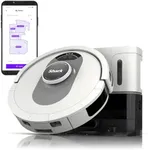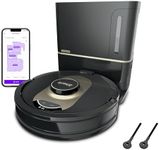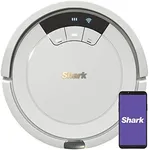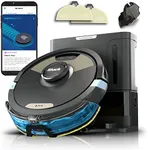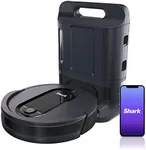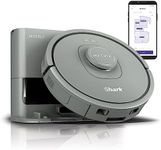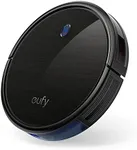Buying Guide for the Best Shark Robotic Vacuums
Choosing a robotic vacuum can make cleaning your home much easier and more convenient. When picking the right one, it's important to think about your living space, the types of floors you have, and your daily routine. Understanding the key features will help you find a model that fits your needs and keeps your home tidy with minimal effort.Suction PowerSuction power refers to how strongly the vacuum can pull in dirt and debris. This is important because higher suction means better cleaning, especially on carpets or with pet hair. Suction power is often measured in Pascals (Pa) or sometimes just described as 'strong' or 'standard.' For mostly hard floors, a lower suction level is usually enough, while homes with thick carpets or pets may benefit from higher suction. Think about your floor types and cleaning needs to decide how much suction is right for you.
Battery LifeBattery life tells you how long the vacuum can run before it needs to recharge. This matters because a longer battery life means the vacuum can clean more space in one go. Battery life is usually given in minutes, ranging from about 60 to 120 minutes or more. If you have a small apartment, shorter battery life is fine, but for larger homes, look for longer battery life so the vacuum can finish cleaning without stopping to recharge.
Navigation SystemThe navigation system is how the robot finds its way around your home. Some use random patterns, while others have smart mapping to move in straight lines and remember your rooms. Basic navigation is okay for simple spaces, but if you have a complex layout or lots of furniture, a model with advanced mapping will clean more efficiently and avoid missing spots. Consider your home's layout when choosing the right navigation system.
Dustbin CapacityDustbin capacity is the size of the container that holds the dirt and debris. A larger dustbin means you have to empty it less often, which is convenient if you have pets or a bigger home. Smaller dustbins are fine for light cleaning or smaller spaces. Think about how much dirt your home collects and how often you want to empty the bin to pick the right size.
Filter TypeThe filter type affects how well the vacuum traps dust and allergens. HEPA filters are best for people with allergies because they capture tiny particles. Standard filters are fine for general cleaning. If you or your family have allergies or pets, look for a vacuum with a high-quality filter to keep the air cleaner.
Smart FeaturesSmart features include things like app control, voice assistant compatibility, and scheduling. These make it easier to control the vacuum and fit cleaning into your routine. If you like using your phone or smart home devices, look for models with these features. If you prefer simple operation, basic models without smart features may be enough.
Height and SizeThe height and size of the vacuum determine where it can fit and clean, such as under furniture. Lower-profile models can reach under couches and beds, while larger ones may have trouble. Think about the spaces you want cleaned and measure the gaps under your furniture to make sure the vacuum can reach them.
